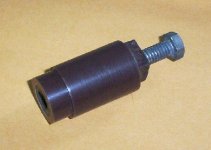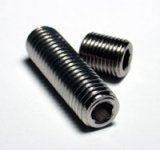I have had a little bit of trouble "screwing" the pin when attaching the forearm to the handle (I have drilled and tapped the handle to accept a 3/8 10 pin). It gets difficult screwing the pin in once it get down there a bit. I have thought about using a towel and some pliers but fear it may damage the pin. Anybody have any ideas?
You are using an out of date browser. It may not display this or other websites correctly.
You should upgrade or use an alternative browser.
You should upgrade or use an alternative browser.
Specialized Tool Question
- Thread starter Run the Century
- Start date
Delrin
I'm sure there are a lot of ways to do it and mine might not be the best. I just made a 1" diameter delrin sleeve to go over the pin that is cut down the side like a collet. You can then grab that with pliers to get a little better hold on it. I haven't had any problems doing it this way and it doesn't damage the threads.
Run the Century said:I have had a little bit of trouble "screwing" the pin when attaching the forearm to the handle (I have drilled and tapped the handle to accept a 3/8 10 pin). It gets difficult screwing the pin in once it get down there a bit. I have thought about using a towel and some pliers but fear it may damage the pin. Anybody have any ideas?
I'm sure there are a lot of ways to do it and mine might not be the best. I just made a 1" diameter delrin sleeve to go over the pin that is cut down the side like a collet. You can then grab that with pliers to get a little better hold on it. I haven't had any problems doing it this way and it doesn't damage the threads.
CamposCues said:I'm sure there are a lot of ways to do it and mine might not be the best. I just made a 1" diameter delrin sleeve to go over the pin that is cut down the side like a collet. You can then grab that with pliers to get a little better hold on it. I haven't had any problems doing it this way and it doesn't damage the threads.
You can also do the same thing with a short piece of delrin or other material, by simply drilling and tapping a shallow hole. screw it onto the end of your pin until it bottoms out, then use that as a handle to screw the pin in. This works great for joint pins too.
Thanks guys - I tried that with a wood piece and it split - a harder material should work. BTW - I have been trying to find the material that Mottey and Scruggs use for their butt caps - its a white somewhat translucent material - is it Delron and where can I buy it?
That's Delrin/Acetal.Run the Century said:Thanks guys - I tried that with a wood piece and it split - a harder material should work. BTW - I have been trying to find the material that Mottey and Scruggs use for their butt caps - its a white somewhat translucent material - is it Delron and where can I buy it?
Availably thru Prather, Atlas or McMaster-Carr.
Run the Century said:Thanks guys - I tried that with a wood piece and it split - a harder material should work. BTW - I have been trying to find the material that Mottey and Scruggs use for their butt caps - its a white somewhat translucent material - is it Delron and where can I buy it?
Here is basically what the others have described except for it has a lock screw in the other end so the 3/8 x 10 screw doesn't lock up in the tool. It also lets you use the nut on the top to drive the screw. I put a small piece of leather in the hole so the screw at the top doesn't mar or scratch the screw you are installing. As far as Delrin goes, call around and see what you can find where you live. It's a common product and Atlas is a little over priced on it. The ivory type though I haven't found anywhere else other then Atlas although I haven't really tried, I am sure I could track it down at a better price if I wanted it.
Attachments
Last edited:
Make an oversized joint protector, out of teflon or delrin. Thread the screw into the joint protector, then use it as a handle to turn the pin into the wood. The bigger the outside diameter, the more leverage you will have. After the pin sets up in the handle the pin setting tool will easily thread off of the pin. Also if the handle and the tool are both faced properly, it will help get the pin straight. You can also put a pilot on the pin setting tool and a recess in the handle, that will give you even better alignment. Are you using glue relief holes? Mottey's butt caps are delrin, good luck gluing that stuff.Run the Century said:I have thought about using a towel and some pliers but fear it may damage the pin. Anybody have any ideas?
Tracy
Run the Century said:I have had a little bit of trouble "screwing" the pin when attaching the forearm to the handle (I have drilled and tapped the handle to accept a 3/8 10 pin). It gets difficult screwing the pin in once it get down there a bit. I have thought about using a towel and some pliers but fear it may damage the pin. Anybody have any ideas?
I use 3/8 - 10 threaded rod in between my forearms and handles. I cut it to length then put in in my bench vise in between two pieces of 2x4 and cut a slot on the ends with a hack saw and screw it in with a flat head screw driver. this works fine for this because it is hidden in the cue. I like the methods mentioned by others better because you can use it for joint pins also.
Owen
double nuts work just fine. i bought some steel hex stock, cut off slices, drilled and tapped in lathe. 2 each of radial, 3/8 10 and 5/16 14. can use them for removing bent joint pins even. just run both nuts on and tighten against each other the use the wrench on the back one, this obviously depends on which way you are going. been using the same old nuts i made 6 or 8 years ago with no problems. hope this helps.
depth tool
Try using a depth tool that is used for installing joint pins. This depth tool will make sure your pins stick out the same on each cue.
Here's how to build one.
Start with a 1" round alumium rod, drill and tap for your pin [3/8 x 10 ], to the length you want the pin to be expossed. Most pins stick out about 1" to an 1-1/8th or so. Tap the other end of the round, to 3/8 x 16 thread and install two allen set screws, one on top of the other. This will keep the pin lenght from changing with one screw on top of the other one.
When installing pins in joints or in handles, use this same tool, just put it in the chuck and glue up, and spin slow till you bottom out or to the depth you want in your handle.
hope this will help you out.If you need more help, just call me @ 830-232-5991.......
blud
Run,Run the Century said:I have had a little bit of trouble "screwing" the pin when attaching the forearm to the handle (I have drilled and tapped the handle to accept a 3/8 10 pin). It gets difficult screwing the pin in once it get down there a bit. I have thought about using a towel and some pliers but fear it may damage the pin. Anybody have any ideas?
Try using a depth tool that is used for installing joint pins. This depth tool will make sure your pins stick out the same on each cue.
Here's how to build one.
Start with a 1" round alumium rod, drill and tap for your pin [3/8 x 10 ], to the length you want the pin to be expossed. Most pins stick out about 1" to an 1-1/8th or so. Tap the other end of the round, to 3/8 x 16 thread and install two allen set screws, one on top of the other. This will keep the pin lenght from changing with one screw on top of the other one.
When installing pins in joints or in handles, use this same tool, just put it in the chuck and glue up, and spin slow till you bottom out or to the depth you want in your handle.
hope this will help you out.If you need more help, just call me @ 830-232-5991.......
blud
I use a 3/8-16 cap head screw. The cap head screws take an allen wrench in one end, makes it easy to screw into the wood. I mark the pin in the before I screw it in and just stop at the half way mark. Fill the voiid on the end with epoxy to remove any hollow spots.
These are much cheaper that 3/8-10 pins and you can use a standard tap.
Mike
These are much cheaper that 3/8-10 pins and you can use a standard tap.
Mike
Attachments
Mike, you use that as weight bolts or A-joint stud?Pancerny said:I use a 3/8-16 cap head screw. The cap head screws take an allen wrench in one end, makes it easy to screw into the wood. I mark the pin in the before I screw it in and just stop at the half way mark. Fill the voiid on the end with epoxy to remove any hollow spots.
These are much cheaper that 3/8-10 pins and you can use a standard tap.
Mike
Off topic, how many here use 3/8 10 as A-joint stud?
JoeyInCali said:Mike, you use that as weight bolts or A-joint stud?
Off topic, how many here use 3/8 10 as A-joint stud?
I do, both for weight and at A joint however the A joint studs are cut from six foot all thread to the length that I want and then I cut a flat on the all thread for glue releaf. In that way I can be sure the threaded hole is full of glue to the bottom, with no voids, and still not hydrolic my cue.
I also have jigs for inserting joint pins and mine are made exactly like Bluds with the exception that I have the rear of each one turned to a half-inch so that it can be mounted in My tail stock chuck insuring that it go's in straight.
Dick
Pancerny said:A joint studs only...3 inch.
M
Apparently we are talking about different joints. I've always called the prong to handle joint the A joint. In this area I've used studs from 2" to 8" long. When the question was asked of you if you used a plain steel 3/8X16 stud for the A joint I assumed this is what was being talked about as I've never seen such a stud used for a pin at the shaft joint.
Dick

